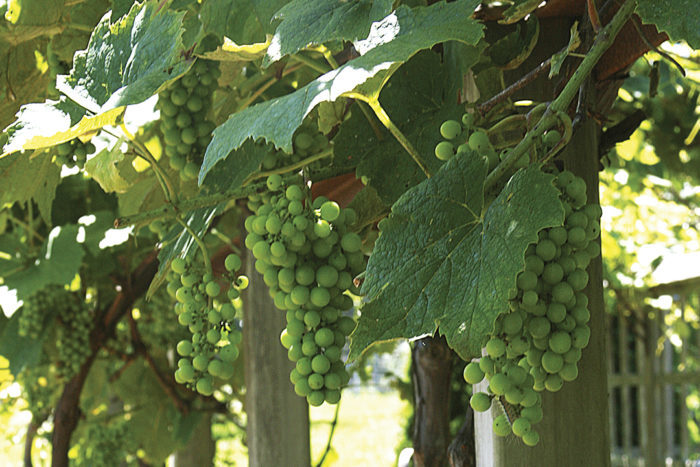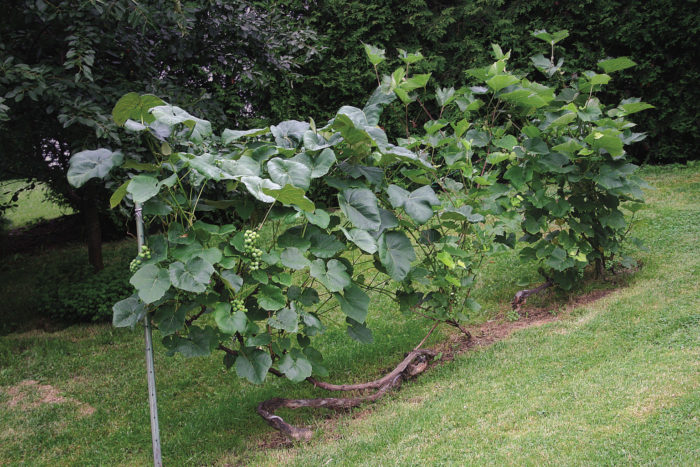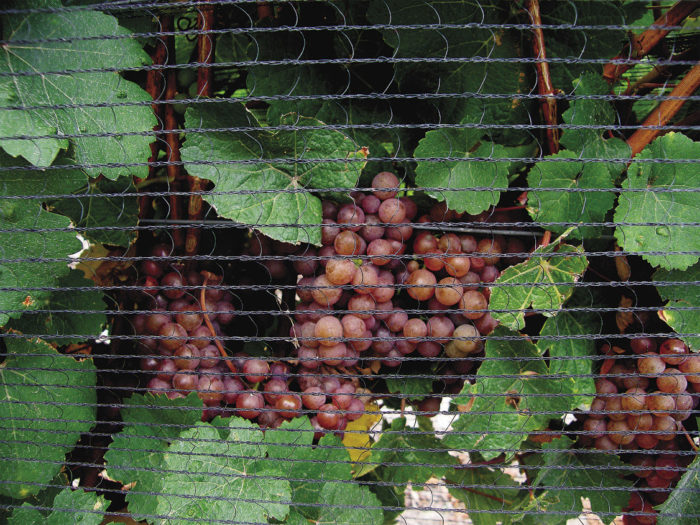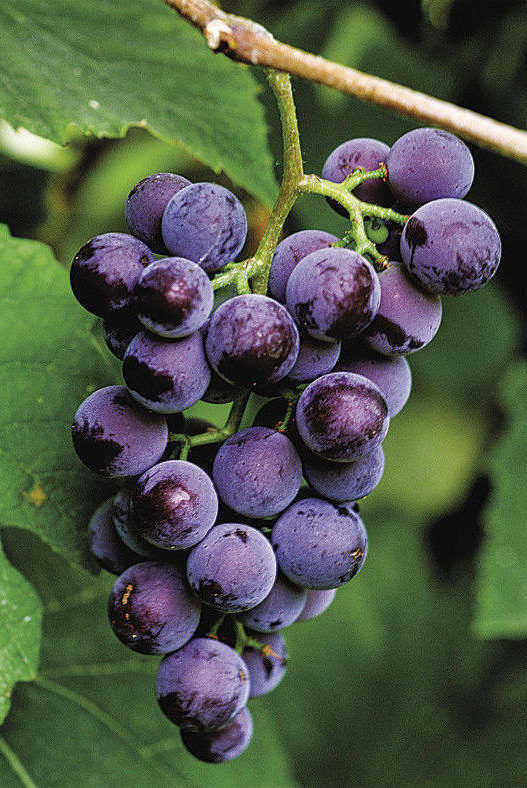Homegrown Grapes
Give these fruits the right light, soil, and a little support from the start and they’ll reward you for years

Some plants are grown strictly for the beauty that they bring to the garden. Some are more utilitarian in nature, grown primarily for food. Then there are plants that offer a sublime combination of the two, lending graceful productivity to the garden. The grape is one of these plants. Luscious clusters of berries are borne on handsome vines that rise from magnificent, gnarled trunks. Delicate tendrils reach out to help the vine grow up and along an arbor or trellis, and deep green foliage cascades from twining branches that become a deep crimson curtain in autumn. Fruit colors and flavors range from bright, crisp greens to deep, sweet, musky purples.
Grapes are adaptable to many regions in North America. No longer the exclusive province of wineries, grapes are now being grown by home gardeners. Provided with full sun, well-drained soil, support, and pruning, grapevines will reward the home gardener with delicious fruit for years.
Get the sun, soil, and water right
Grapevines require full sun and high temperatures to ripen the fruit; therefore, choose the sunniest spot you have—ideally one with southern exposure. Sun not only provides the energy the plant needs but also keeps the foliage dry, which helps prevent diseases.
Before planting, remove all canes from the plant except the most vigorous one, and cut this cane back to two or three buds. This limits the vine’s early growth, so one strong cane can be chosen for the trunk. Dig a hole large enough so that you can spread out the root system. If planting a grafted vine, plant with the graft union about 6 inches above the soil line to prevent the scion from forming roots. Potted vines should be planted at the same level that they were in the pot; the vine is accustomed to being planted at this depth, and the roots will be at the right depth in the soil.
Replace the soil around the roots, gently tamping as you go. Immediately after planting, water the vine in—two to three gallons should do it—then water regularly and deeply during the first year to encourage deep roots. If the plant is watered shallowly, the roots will never grow deeper than the first few inches of soil, resulting in a weak vine. After the first year or so, grapevines do not require much water.
If you plan ahead, you might want to rake in some well-rotted compost before planting to allow the nutrients to work their way into the soil. Otherwise, simply spread a couple of inches of compost around the base of the vine after planting. Do this in spring for the first two to three years. Once the vine is mature, simply let observation be your guide. If the vine is growing vigorously, you might not need to add any fertilizer at all. You don’t want to overfertilize a grapevine; this can lead to excessive foliage, which shades grape clusters and encourages diseases.
First-year care is critical
Grapes are relatively easy to care for and tolerant of all but wet soil once they are established. If they are properly planted, supported, and trained when they are young, grown-up grapes will reward you for years.
 |
 |
 |
| Purchasing
New bareroot plants should have a full, healthy root system and at least one robust cane. |
Planting
Plant new grapevines in full sun and well-drained soil. If grafted, plant the graft union 6 inches above the soil; if potted, plant at soil level. |
Trellising
Affix the cane to a sturdy trellis with pliable garden tape until the main trunk stays in place and grows in the direction you want. |
All grapevines need support to thrive
Grapevines need some sort of structure on which to climb, not only to make them look nice and to encourage fruiting but also to prevent diseases. Vines grow vigorously and can become dense. Dense foliage is the perfect environment for many plant diseases. Supporting the vine on an arbor, trellis, or fence allows air to move easily through the foliage, helping it dry after rain- or dewfall.

The support for grapevines can be as simple or creative as your imagination allows. As long as the vine is supported and there is a structure for the tendrils to take hold of, the vine should do most of the work itself. To begin training the vine, tie it loosely to a stake or your selected trellis as it begins to grow. Continue to tie new growth to support the vine, and train it in the direction you want it to grow. Remember that grapevines become quite heavy as they grow, so be certain the support is sturdy. Pruning vines annually is a good practice and will also prevent them from becoming too dense.
Beware of birds and beetles
If you’ve planted your grapevine correctly, you’ve already done a lot to prevent potential problems. But there are other measures that you can take to protect against diseases and predators. Keep the area around grapevines free of weeds that can harbor pests and diseases. Japanese beetles can make lacework out of grapevine foliage in a matter of days, rendering the plant unattractive and weak. Monitoring is the key to controlling them. Look for beetles and beetle damage beginning in early to midsummer. At the first sign of damage, start removing the beetles by flicking them into a pail of soapy water. If you do this twice a week for a couple of weeks, the damage to your plants should be minimal.

Perhaps your worst enemy as a grape grower is birds. Birds love the delicious fruit as much as we do and will attempt to get to it before you harvest, even if the fruit is not fully ripe. Netting is the only reliable method to prevent bird damage, especially in large plantings. If you have only a vine or two, individual clusters can be covered with paper bags to prevent birds from feasting. (The grapes themselves don’t need direct sunlight to ripen.) Cover the clusters with the bag—remembering that you want to give the cluster plenty of room to grow inside the bag—and tie the bag closed around the cane. A similar protection could be achieved by wrapping netting loosely around individual clusters and tying it off. These methods might not look great, but they will help keep the fruit safe until you’re ready to harvest.
Avoid pesticides when growing grapes. Grapevines can become stunted or distorted, or can even cease to grow with pesticide use. Most insects are not significant enough problems to warrant chemical application. Hand weeding and keeping a tidy garden help prevent many problems.
A taste test determines when to harvest
Grapes flower on young canes, so you might see fruit as early as a year after planting, though it usually takes a few years for a full harvest. Tasting a few grapes is the best method for determining if the clusters are ready. If the grapes taste sweet and are juicy, they’re ready to pick; if they are firm, are dry, and have a bitter or astringent flavor, they’re not. Most varieties ripen evenly if provided with the adequate sun. So when one cluster is ripe, the rest of them should be, too—but taste a couple just to be certain. Do your best to harvest all grapes when they ripen to prevent overripe fruit, which is not palatable, doesn’t work well for wine or preserves, and can attract wasps and other insects.
Growing grapes is fun and rewarding. The vines are beautiful and provide screening while also producing delicious fruit for eating, juice, or wine. Start small, with just one or two vines. After a couple of years, you’ll see just how much fruit these easygoing vines can produce.
Choosing the right variety is the first step
If you peruse any plant catalog or visit any online nursery, the choices of grape plants can be overwhelming. The following are some of the strongest performers with the best attributes for the zones listed. If your garden is in USDA Hardiness Zones 5 to 9, you will have no trouble finding a wide range of varieties to grow. Gardeners in Zones 3 and 4 might have fewer choices but no less variety when it comes to flavors, colors, and uses.
 |
 |
 |
| Concord | Edelweiss | Catawba |
Emily S. Tepe and Emily E. Hoover are a research fellow and professor, respectively, in the Department of Horticultural Science at the University of Minnesota in St. Paul. They specialize in growing fruit in cold climates.
Photos: millettephotomedia.com; Lynn Felici-Gallant; Abigail Lupoff; Jerry Pavia; Bill Johnson






Comments
Log in or create an account to post a comment.
Sign up Log in